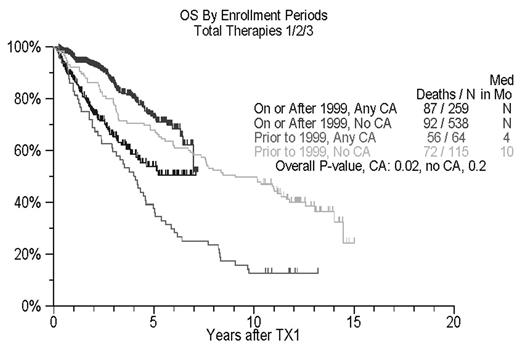Abstract
Background: In 1989, TT with tandem autotransplants (AT) was developed - in analogy to St. Jude’s TT program for childhood ALL - to advance the treatment outcome of MM patients. New agents and treatment principles were introduced as we moved from TT1 to T2 to TT3, mainly to address the inferior outcome in high-risk patients, introducing post-AT consolidation chemotherapy and thalidomide in TT2 and treatment in between chemotherapy cycles/transplants plus bortezomib in TT3. The consistently high-risk associated with the presence of metaphase cytogenetic abnormalities (CA) had been recognized in TT1. We now examine the benefit of intensifying therapy over time in patients with and without CA.
Patients and Methods: According to our MM data base, 979 newly diagnosed patients had at least 1 AT; 181 patients were enrolled prior to 1999 and 798 patients thereafter (566 on TT2 and 232 on TT3). Univariate and multivariate analyses were performed to examine the impact on overall survival (OS) of time of protocol enrollment in the context of pre-treatment laboratory parameters
Results: Pre-treatment features of the 2 cohorts were comparable in terms of frequencies of CA and serum levels of B2M, CRP and creatinine. The recent cohort (after 1999) had higher percentages of patients aged >65yr (22% vs 8%) and with LDH>190U/L (32% vs 7%, p<.001) but lower proportions with albumin<3.5g/dL (2% vs 9%, p<.001) and Hb<10g/dL (19% vs 50%, p<.001). Median OS was superior in the 798 patients enrolled after 1999 compared to the 181 prior to 1999 (not reached vs 72mo, p=.007). Other univariately significant adverse features included CA, B2M>=3mg/L, CRP>=6mg/L (all p<.001); age >=65yr (p=.002), creatinine>1.5mg/dL (p=.007), albumin<3.0g/dL (p=.018) and male gender (p=.049). On multivariate analysis, the following adverse variables entered the model: CA (HR=2.19, p<.001), B2M>=3mg/L (HR=1.79, p<.001), CRP>=6mg/L (HR=1.48, p=.002), age >=65yr (HR=1.44, p=.015), enrollment pre-1999 (HR=1.38, p=.026) and male gender (HR=1.27, p=.047). Importantly, a significant benefit was apparent for the one-third of patients with CA who received TT post-1999 (median not reached versus 4yr, p=.02), whereas there was a trend apparent for those without CA (Figure).
Conclusion: Pursuit of the TT approach has indeed improved the outcome of the one-third of high-risk patients with CA, with a 5-yr OS rate of ~55% post-1999 versus 35% pre-1999.
OS By Enrollment Periods Total Therapies 1/2/3
Disclosure: No relevant conflicts of interest to declare.
Author notes
Corresponding author


This feature is available to Subscribers Only
Sign In or Create an Account Close Modal